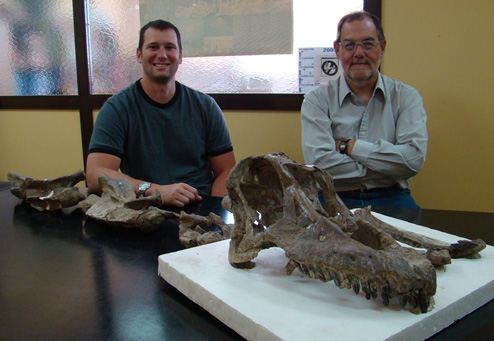Titanosaur Fossil Skull Provides Evidence of Dinosaur Senses
The almost perfectly preserved fossilised skull of a giant, long-necked dinosaur found in Argentina has helped provide palaeontologists with an improved understanding of the senses of dinosaurs. The fossil skull was excavated from Upper Cretaceous strata in the Chubut Province of southern Argentina some years ago, but it was only recently restored and subjected to detailed CT (computerised tomography) scans that allowed scientists to gain an understanding of the size and the structure of the dinosaur’s brain.
Fossil Skull
Scientists Marvel at the 95-million-year-old Dinosaur Skull
Picture credit: Carnegie Museum of Natural History
Describing a Titanosaur Skull
Authors of the scientific paper that has been published in the on-line journal PLOS One include Dr Rubén D. F. Martínez (National University of Patagonia) and Dr Matthew Lamanna (Carnegie Museum of Natural History, Pittsburgh, Pennsylvania), state that this dinosaur skull, a titanosaur, known as Sarmientosaurus is exceptionally rare. Four such skulls have been found to date from locations as far apart as Madagascar and Mongolia but this fossil found in Patagonia, is the best preserved.
For models and replicas of titanosaurs and other saurpod dinosaurs: CollectA Deluxe Prehistoric Life Models.
Analysis of the CT scans has enabled the research team to build up a picture of this large, plant-eating dinosaur’s senses. It had large eyes and very probably excellent eyesight. It also had good hearing, especially well adapted to picking up low frequency airborne sounds. The tooth of a large meat-eating dinosaur was found near the skull fossil, such sharp senses would have been very useful for this Late Cretaceous dinosaur, helping to keep it safe from predators.
Visit Everything Dinosaur’s user-friendly and award-winning website: Everything Dinosaur.


